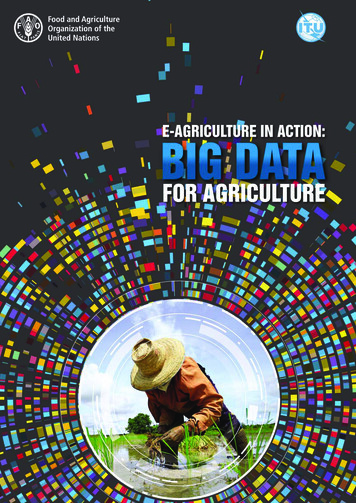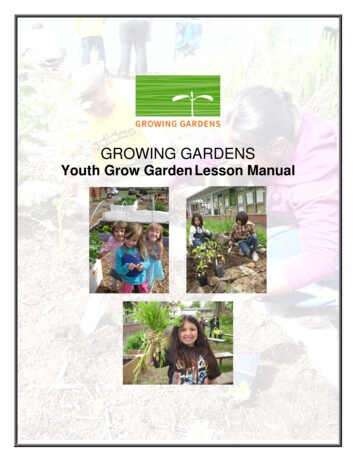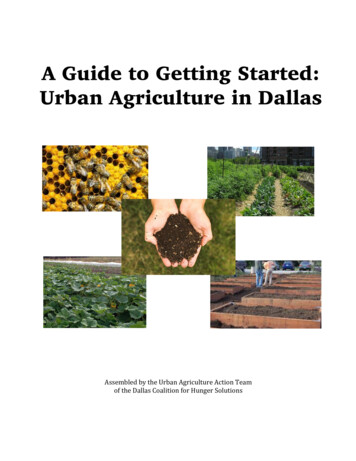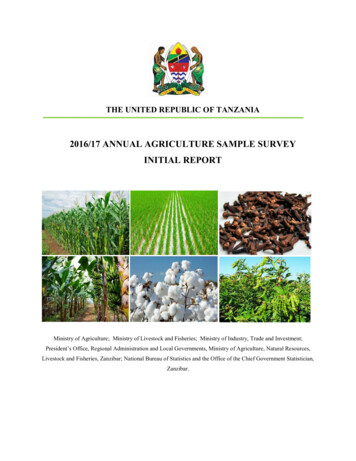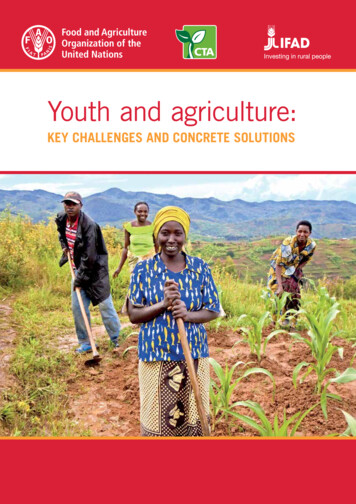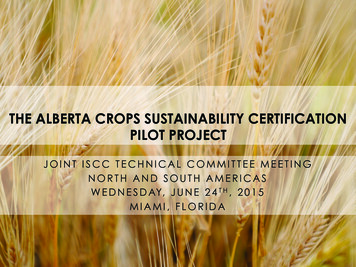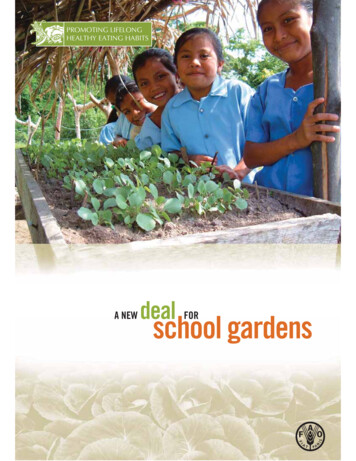
Transcription
PROMOTING LIFELONGHEALTHY EATING HABITSA NEWdealFORschool gardens
The designations employed and the presentation of material in this information product do not imply the expressionof any opinion whatsoever on the part of the Food and Agriculture Organization of the United Nations (FAO) concerningthe legal or development status of any country, territory, city or area or of its authorities, or concerning the delimitationof its frontiers or boundaries. The mention of specific companies or products of manufacturers, whether or not thesehave been patented, does not imply that these have been endorsed or recommended by FAO in preference to othersof a similar nature that are not mentioned.The views expressed in this information product are those of the author(s) and do not necessarily reflect the views of FAO.ISBN 978-92-5-106615-7All rights reserved. FAO encourages the reproduction and dissemination of material in this information product.Non-commercial uses will be authorized free of charge, upon request. Reproduction forresale or other commercial purposes, including educational purposes, may incur fees. Applicationsfor permission to reproduce or disseminate FAO copyright materials, and all queries concerning rights and licences,should be addressed by e-mail to copyright@fao.org or to the Chief, Publishing Policy and Support Branch,Office of Knowledge Exchange, Research and Extension, FAO, Viale delle Terme di Caracalla, 00153 Rome, Italy. FAO 2010Cover photo: Plenty (http://Plenty.org)Text: Jane Sherman,Design: Maxtudio
contentsIntroduction1234567School gardens: why, what and how?3A little history, and some examples5Needs and approaches7The new school garden11Garden learning15The garden curriculum17Frameworks for innovation21Challenges and keys to success23
ForewordAAs environmental concerns broaden and diet-related health and nutritionproblems increase, governments and development partners are increasinglyinterested in the potential of school gardens.School gardens are cultivated areas around or near to schools, tended at least partly by learners. Mainlythey produce vegetables and fruits; activities may include small-scale animal husbandry and fishery,beekeeping, ornamental plants and shading, and small-scale staple food production.School gardens are run for a variety of reasons. Some that are gaining prominence in all parts of the worldare the promotion of good diet, nutrition education, and the development of livelihood skills, together withthe power to extend this learning beyond the school itself in a variety of ways.This educational focus canbe an important long-term contributor to national health and food security.This document suggests what governments and their development partners can do to promote schoolgardens as a seed ground for the nation’s good nutrition and better health.Ellen MuehlhoffSenior OfficerNutrition Education and Consumer Awareness GroupNutrition and Consumer Protection Division2A NEW deal FOR school gardensEzzeddine BoutrifDirectorNutrition and Consumer Protection Division
FAO/Marco LongarIntroductionSchool gardens: why, what and how?NNew needs, new rolesGovernments and international development partners are increasingly interested in school gardens. These havetraditionally been used for science education, agricultural training or generating school income. Today, given theurgent need for increased food security, environmental protection, more secure livelihoods and better nutrition,perceptions of the potential of school gardens are changing. Some roles which are gaining prominence are thepromotion of good diet, the development of livelihood skills, and environmental awareness. The belief is thatschool gardens can become a seed ground for a nation’s health and security; this idea is increasingly backed up byexperience and research. The questions are: how much can be achieved, and how best to go about the task?The potentialSchool-age children need a good diet in order todevelop and grow well, to study, to be protectedfrom disease, and to have the energy to get throughthe day. For the sake of their futures and their ownchildren’s futures, they need not only to eat well, butalso to learn how to eat well, and how to grow theirown food if necessary. Schools are well placed toshow children how to go about this, because at thisage children are open to new ideas and young enoughto pick up good habits and new skills easily. With theright conditions and support, school gardens can doall of these things: show children how to grow a variety of foods –vegetables, fruits, legumes, small animals – and dothis with a good diet in mind; demonstrate to children and families how to extendand improve a diet with home-grown foods; increase children’s preference for and consumption ofvegetables and fruits; enhance school meals with micronutrient-richvegetables and fruits; promote, or re-establish, horticultural skills inagriculture-dependent economies; foster entrepreneurial skills in the area of marketgardening;A NEW deal FOR school gardens3
FAO/Giuseppe BizzarriSchool-age children need a good diet in order todevelop and grow well, to study, to be protectedfrom disease, and to have the energy to getthrough the day. raise awareness of the need for environmentalprotection and soil conservation.Putting learning firstThe garden curriculum: School gardens cannot singlehandedly raise the level of children’s health orsubstitute for school meals – but they can contributeto them. Above all, they must be an educationalinstrument targeting not only children, but alsotheir families, the community, and the school itself.Hence, garden activities should support and besupported by classroom lessons. The curriculum ismultidisciplinary: The core garden curriculum consists of learninghow to grow food, how to harvest it, how topreserve it and how to prepare it, and to do so withdue respect for the environment. Curriculum areasare horticulture, environmental studies and homeeconomics. This process must be led by conscious choicesabout what to grow to improve diets (nutritioneducation), or about what to grow to sell (marketgardening / business studies). Experiential learning should be mixed with sociallearning and life skills, to move learning intoreal-life practice, motivate lifestyle change andbroadcast the message. For example:– learners must manage, observe, record,evaluate and celebrate the whole process;– the skills of disseminating and publicizinggarden learning are part of the curriculum.Challenges and secrets of successSchool garden learning is different from most otherlearning programmes: it is multi-sectoral andmultidisciplinary; it relates closely to school food;it is usually partly extra-curricular; it may requireequipment and infrastructural support, especiallywater supply; gardens may need attention out of theschool term.Other important issues are: the need for expertise andtraining in garden management and horticulture;issues of curriculum integration; monitoring andevaluation; and support and encouragement for hard-4A NEW deal FOR school gardensworking school staff. All these suggest the need forcareful planning and long-term support, rather thanquick fixes.Many secrets of success are local: having clear, sharedaims; paying attention to attitudes; giving the gardenvisible value in the eyes of the community, withclear links to good health and school food; buildingsupport from families and school management; wholeschool participation; some ownership and control bychildren; committed garden managers and interestedschool cooks. Some well-documented success storiessuggest that the most sustainable programmes oftengrow organically: they start small, take little forgranted and expect slow progress; they allow schoolsto opt in and later to ‘graduate’ and help others; theyoffer small incentives and long-term coordination.All of these factors should be taken into accountwhen deciding the best way forward and how farthe process of setting up, reviving or re-orientingschool gardens should be divided between top-downfacilitation and bottom-up initiative. Governmentcan take the lead with appropriate resources,inputs, training, educational materials, advice andencouragement, and can help to establish a strongeducational profile based on the food cycle and linkedto the mainstream curriculum. It may also need toexplore ways of helping schools to help themselves.Research supportThere is clear and growing evidence that: consuming specific vegetables can have a markedeffect on children’s health; growing and preparing garden food at schoolincreases children’s preferences for healthy fruit andvegetables; food gardening, combined with nutrition education,results in voluntary changes in diet; gardening activities, especially with organicapproaches, improve children’s understanding of andattitudes to the natural environment; hands-on learning and learning by doing induce amuch higher retention rate than ‘chalk and talk’.
FAO/Simon MainaA little history, and some examplesSSchool gardens have a long historyThe story is one of diverse aims, changing practices,fluctuating commitment and, today, renewed relevance.In different historical contexts, school gardens havehad different priorities. Such differences in backgroundexperience will inevitably affect each government’spolicies and programmes.In the North, ‘garden-based learning’ haspredominated, using gardens as laboratories for handson learning of science, environmental studies, andother subjects such as art and language. More recently,garden enthusiasts have been especially concerned atthe growing alienation of urban youth – not only fromnature but also from the sources of the food they eat –and have rekindled an interest in food gardening andnutrition: the ‘edible school yard’. Much has been doneto promote school gardens and to integrate them intothe existing curriculum, but the battle for recognitionof their educational value continues.In the South, educational use has been mainly forvocational agricultural training, which has sometimesproved to be a resilient curriculum element (e.g. inSwaziland, Botswana and Uganda) in spite of resistanceto ‘ruralisation’ of the curriculum. Otherwise, the mainorientation of school gardens has been food productionfor consumption or cash, often with the hope that thegardens might help to supply the school meals whichmake such a difference to children’s health, attendanceand educational success. Such initiatives have oftenproved unsustainable through lack of resources,motivation or expertise. However, some countries (e.g.Costa Rica) have long-established policies of associatingschool gardens with school food and improvingchildren’s nutrition and eating habits; many shiningexamples of individual schools and projects demonstratethat the potential is there.Today, perceptions of school gardens arechanging in response to increasingly urgent needsfor greater food security, environmental protection,more secure livelihoods and better nutrition. Schoolgardens have new multiple roles to play.Some examplesBanareng Primary School in Pretoria, South Africahas transformed an urban desert into a flourishingherb and vegetable garden. The garden depends onhard work, sales of food, recycling, and the occasionaldonation. See www.lu.se/o.o.i.s/8527Sligoville School in central Jamaica has a large organicgarden worked by children, staff and the community.It provides food for meals, to take home, and to sell,A NEW deal FOR school gardens5
FAO/Marco LongariSome countries have long-established policies ofassociating school gardens with school food andimproving children’s nutrition and eating habits.and inspires many educational projects. See www.farmradio.org/english/radio-scripts/48-7script en.asp FAO/Ami VitaleHikmet Ulubay Boarding School in Turkey hasagriculture classes and two large greenhouses wherechildren grow fruit and vegetables for meals in thecafeteria. See The White House food garden in Washington D.C.,started by children from Bancroft Elementary School,will provide food for the President and his family,but, says Michelle Obama, its most important rolewill be to educate children about healthful, locallygrown fruit and vegetables. “My hope,” the First Ladytold Marian Burros of The New York Times*, “is thatthrough children, they will begin to educate theirfamilies, and that will, in turn, begin to educate ourcommunities.”Marian Burros, Obamas to plant vegetable garden at White House,New York Times, March 19, 2009The Edible School Yard in Berkeley, California,introduces children to healthy food. They grow foodorganically, rear chickens, taste and compare food,prepare it and eat it. Garden learning is integratedacross the curriculum. See www.edibleschoolyard.org/6A NEW deal FOR school gardens
FAO/Djibril SyNeeds and approachesNNeedsUrgent needs are dictating a worldwide re-appraisal ofthe potential of school gardens.Basic food security is under threat from climatechange, increased demand for food, rising foodprices, higher input costs and loss of agriculturalskills and human resources. Governments arereconsidering agricultural policy and the role to beplayed by a knowledgeable and skilled population infeeding themselves and others.Environmental protection is now an imperative, forcingattention onto fuel and water conservation, soilenrichment, reforestation and organic approachesto horticulture, even at the micro level of the schoolback yard and the home food garden.Livelihoods are threatened by the global financialcrisis and resulting economic downturn, as well asby climate change, and young people are particularlyvulnerable. In agriculture-dependent economies itmakes sense for them to develop their horticulturaland entrepreneurship skills.Nutrition needs remain huge: about one person inseven is undernourished and more than one-thirdof infant mortality is attributable to undernutrition.Diets deficient in energy and low in protein qualityand micronutrients impede schoolchildren’s growth,make them vulnerable to illness, stunt their learningcapacity and decrease their life expectancy.School gardens, food insecurityand climate change“Floods and droughts are getting steadily worse inNsanje, Malawi. Harvests are suffering badly. Familiesare not getting enough to eat and children often goto school hungry Flooding has damaged schoolbuildings, and desks and books have been swept away.It has also contaminated water sources, making pupilsvulnerable to malaria and diarrhoea. To provide schoolmeals, Action Aid is helping communities to establishkitchen gardens in four primary schools.”Source: www.actionaid.org.uk/101660/malawi schoolgardens and education.htmlA NEW deal FOR school gardens7
Livelihoods are threatened by theglobal financial crisis and resultingeconomic downturn, as well as byclimate change, and young peopleare particularly vulnerable.The plague of obesity, with its attendant health risks,is spreading from the developed to the developingworld and striking children who are unable to resistthe lures of junk food and a sedentary life in front ofthe TV or computer.ApproachesFood solutions A better diet means, among otherthings, more fruit, vegetables and legumes, greatervariety (especially in the hungry season), enrichedcomplementary feeding for infants and youngchildren, iodised salt, and clean safe water. Theseare not beyond the bounds of possibility for mostfamilies. Natural food solutions are cheap, createlong-term dietary habits, put dietary control into thehands of the consumer, improve the local economy,and develop agriculture. They can all be demonstratedand practised through school gardens, and will havea real effect on diet provided that garden activitiesare reinforced by nutrition education and are carriedthrough to healthy eating.Models for home food gardens and home eatingA number of school garden projects have beensuccessful in inspiring imitative home food gardensand good eating in the family. Some of the secrets ofsuccess are to respect local expertise, provide familiarproduce, propose small acceptable changes, and showclear links to children’s health and food preferences.School meals Although the garden cannot feedthe whole school, it can make a difference bycontributing essential health-preserving fruit andvegetables, and sometimes poultry, meat or fish,to basic rations of cereals, legumes and oil. If theschool is a model for home food gardens and homemeals, a healthy diet can be extended beyond schoolhours and through the holidays. The educational8A NEW deal FOR school gardens FAO/Giuseppe BizzarriWhat can school gardens contribute to meeting theneeds outlined above? Experience is growing offeasible, economical and sustainable approaches tomeeting these fundamental human needs, in whichschool gardens can play an important role.Model gardensA Malawi school garden / home garden projectused school gardens to good effect: throughdemonstrations, cascade training, field days,demonstration plots, messages taken home by pupils,and discussion, the number of backyard gardens roseconsiderably.Source: l is paramount: learners, families, cooks,school staff and the community must make theconnection between growing food and good eating,and the school garden must show this connection.Environment Garden activities have been shownto improve children’s attitudes to the naturalenvironment, especially with organic approacheswhich generate practical understanding of theenvironment and its ecosystems.The food garden should be seen as only one part ofthe whole “school environment project” This would
FAO/Giulio Napolitano FAO/Peter DiCampo FAO/Giuseppe BizzarriThe combination of nutrition education andvegetable gardening has a proven impact on diet.include paths, rough ground, weed patches, watersupply, ponds, environmental planting of decorativeflowers, living fences, lawns, woodlots, shade treesand other amenities. Practical responses to thenatural environment need to be reinforced in thecore curriculum, with subjects such as biology andenvironmental science taking the garden as theirlaboratory and showcase.Livelihood skills In agricultural societies, these arerenewed and extended by practice in horticultureand small animal husbandry. Food processingand marketing can be practised by older learners,developing important entrepreneurial skills.Household skills such as food preserving, mealplanning, nutrient-saving food preparation,food hygiene and energy-saving cooking areA learning opportunity missedA major project successfully produced micronutrientrich foods in the school garden and incorporated themin school meals. The project evaluation found that thechildren were eating better, but that neither they northeir parents knew it. What was lost here?re-examined and revalued, and build a base for foodrelated jobs (e.g. catering), as well as for good familyliving.Education The crucial importance of education toremedy ignorance, mistaken attitudes, poor practicesand skills gaps, is becoming clear through bothsuccess stories and failures. It is evident, for example,that in both rich and poor urban environments directexperience of food production is being lost. It is alsothe case that the majority of people (including theeducated) simply do not recognize the connectionbetween good diet and good health. Many mistakensocial convictions about food values influence dailypractices and can be tackled most directly throughfood education via garden produce.Gardening and nutrition education: a winningcombination Research suggests a strong synergybetween gardening and nutrition education. There is growing evidence that food productionalone makes little impact on dietary practicesunless it is backed by nutrition education.Conversely, the combination of nutrition educationand vegetable gardening has a proven impact ondiet.A NEW deal FOR school gardens9
In the same way, it has been frequentlydemonstrated that nutrition education whichfocuses only on knowledge seldom transfers topractice. On the other hand, direct gardeningexperience can increase children’s preference forvegetables and demonstrably result in catieducation FAO/J. RazuriGooddietBeliefs and attitudes which affect healthnegatively Meat is food for men. Fried chicken and chips is a super-meal, a luxuryto aspire to. Indigenous vegetables and fruits are poorpeople’s food, only to be eaten in hard times. Children do not like green leafy vegetables. It is shameful to take a sweet potato or maizecob to school as a snack. Imported or shop-bought foods are best. Girls must not eat eggs. Breastmilk must be supplemented with otherfoods as soon as possible. Young babies thrive on thin porridge alone. Cola is a status drink. The staple food is ‘real food’ and cannot bevaried.10A NEW deal FOR school gardens
FAO/Giuseppe BizzarriThe new school gardenAA model of the school garden is emerging whichis more widely relevant to today’s needs. Aimingat ecoliteracy, livelihoods, better eating, nutritioneducation and life skills, it prioritizes experientialeducation, integrates several subject areas, andextends its influence to the whole school, the familyand the community.Putting learning firstThe first challenge is to establish the learning agenda.Most existing gardens have both educational andnon-educational objectives, and schools will not wishto give up the material benefits of income, food,improved diet, and environmental comfort. Many ofthese are also essential to educational goals sincechildren cannot learn to grow food without actuallygrowing food.However, schoolchildren cannot realistically orethically be expected to produce significant income,feed the entire school, or make a marked impact ontheir own health, just through school gardening. A firstpolicy decision is therefore to prioritize educationalgoals for children’s garden activities. Learning isthe business of schools, and only learning can helpindividuals to cope with future life, empower society toprotect itself, and reduce dependence on aid.Putting learning first raises some challenges. Forexample: Schools may find themselves torn betweenpractical and educational objectives. Time is an issue: making garden activities fullyeducational doubles the time required. A place in the curriculum is generally seen asimportant to the success of a garden programmeand to nutrition education, its essentialcompanion. Yet the curriculum is alwaysovercrowded and under pressure.A multidisciplinary curriculumGarden-based learning (GBL) is “an instructionalstrategy that utilizes the garden as a teaching tool”(Wikipedia). This wide definition covers everythingfrom mathematics to art. But food gardens havetheir own essential core curriculum. What are itscomponents?A NEW deal FOR school gardens11
The core learning agenda is common to both richand poor communities, linked by their shared FAO/Antonello Protoconcerns for agriculture, the environment, healthand livelihoods.Gardens are the right place, sometimes the onlyplace, to learn how to: cultivate food successfully; respect the environment in direct practice (e.g.conserving water, replacing trees); see the bond between gardening andgood nutrition, and learn to grow a healthydiet; value fresh vegetables, fruits and legumes,including indigenous foods; store and preserve foods and prepare them safely; appreciate the links between diet and health; apply concepts of good diet and healthy lifestyle toone’s own practices; resist junk food; market and sell food; explain and demonstrate one’s learning andunderstanding to others.This core learning agenda is common to bothrich and poor communities, linked by their sharedCore subjects for the school gardenconcerns for agriculture, the environment, health andlivelihoods. This makes for fruitful joint efforts andexchanges of experience and ideas.How does this garden curriculum link to themainstream curriculum? At the core are the basic horticultural practicesof the growing cycle. If Agriculture is in thecurriculum it will guide this programme. Sciencecan be called on at all points to illuminate thesepractices and explore them experimentally. Garden practices must respond to environmentalconcerns and are therefore informed and guided atall points by Environmental Studies. If gardening is to have a real long-term effecton children’s diets, then nutritional needs mustprovide the overall rationale for garden activities,governing decisions about what to plant and whatto do with the produce. Educationally, gardenactivities should be framed, motivated, explainedand extended by Nutrition and Health Education. If learners take on the marketing and sale ofgarden produce, Business Studies will also becomerelevant, generating decisions about what to growand how to handle the produce.Thus the garden learning framework is multidisciplinary, bringing together several curriculumNutrition educationGoals and educational ture12A NEW deal FOR school gardensEnvironmentalStudiesOne conclusion of a workshop on garden-basedlearning held in Zimbabwe in 2007: “School gardensshould be primarily for educational purposes. Thegarden should be linked to good nutrition, puttingeducation first. The long-term goals should be foodsecurity and healthier lives for children and society.Other objectives should be income generation,practical life skills, and entrepreneurship. All these need to be balanced in a principled way.”Source: www.fao.org/docrep/010/a1432e/a1432e00.htm
FAO/I. De Borhegyi FAO/Marco LongariNutrition leads the way“When the purpose of gardening is to increasemicronutrient intake in the diet of vulnerablegroups, nutrition and local food habits should bepredominant considerations in the selection ofcrops.”Source: Preventing micronutrient malnutrition. www.fao.org/docrep/x0245e/x0245e00.htmareas (see the Garden Curriculum diagram on page18). A single focus, for example on horticulture alone,sacrifices many learning possibilities, while without anutrition education framework the primary meaning ofthe school food garden is lost.Intersectoral responsibilitiesAt the policy level, this multidisciplinarity needsto be reflected in some intersectoral commitment.Government initiatives tend to be housed in theEducation Ministry, with support from Agriculture.Health and Nutrition services and environmentalagencies should also be represented. NGO activitiesfocusing on food production or horticulture alsoneed to make sure that nutritional, educationaland environmental aspects are not neglected. Thebalance needs to be redressed, especially in favour ofnutrition, nutrition education and the environment.The multidisciplinary view also underlines theneed to build capacity across the board. It is not onlychildren and teachers who must learn: nutritionistsand agriculturists need to learn about education;agriculturists need to learn about nutrition andnutritionists about agriculture; educators need tolearn about both; everyone needs to learn about theteachers, the children and their families. Time mustbe allowed for this.PartnershipNGOs, Junior Farmer Field and Life Schools,charities, and local organizations with relevant fieldexperience have access to funds and often haveconsiderable expertise, both technical and practical.There are also possibilities for partnership withcommerce, industry and the media: for example,firms sponsor schools and garden competitions;companies train teachers; supermarkets buyschool garden produce; universities include schoolgarden prizes in their award ceremonies; radioand newspapers adapt farming programmes forschools and publicize school garden events andachievements.The wider sceneA strong education focus can extend the impact ofschool gardens to other places and participants.Within the school, learning can move to informalsettings such as the cafeteria, school kitchen, schoolsnack stall or tuck shop. Other players have learning/teaching roles: cooks request nutritious ingredientsfor school meals, school boards formulate policy andFood gardens have their ownessential core curriculum.A NEW deal FOR school gardens13
muster support, the Parent Teacher Association (PTA)discusses inputs and budget, school staff plan harvestfestivals, caretakers advise on fencing and security,food vendors sell garden produce. An area cluster ofschools can share experience and expert staff, andhold local competitions.The semi-public position of the school garden inthe ‘community backyard’ extends its educationalvalue beyond the school. Visitors can see what isbeing done and learners can show off their learning.As the garden grows so does the confidence oflearners, who can begin to promote its activities and14A NEW deal FOR school gardens FAO/Peter DiCampoThe Growing Connection In South Africa, the National School NutritionProgramme (NSNP) within the Departmentof Education unites school gardens, schoolfeeding and nutrition education. A garden-based learning project in theBahamas is located in the Ministry ofEducation, which provides a curriculumspecialist but has a project coordinator fromAgriculture and a nutritionist seconded fromthe Health Ministry. In 2008, a large-scale initiative in Jamaicato resuscitate school gardens and improveschool meals in collaboration with the 4HClubs was spearheaded by the Ministry ofAgriculture, supported by the Ministry ofEducation. The Ghana Organic School Project, whichlinks school gardens and local organicfarming to school meals, is mounted byOxfam in collaboration with Farmer FieldSchools and the Dutch AgroEco Foundation. The Growing Connection is a grassrootsproject developed by FAO which campaignsto introduce low-cost water-efficient foodgrowing innovations in school gardensand community gardens. It is supportedby a coalition of
2 A NEW deal FOR school gardens A As environmental concerns broaden and diet-related health and nutrition problems increase, governments and development partners are increasingly interested in the potential of school gardens. School gardens are cultivated areas around or near to schools, tended at least partly by learners. Mainly

